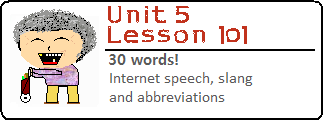 Lesson 101: In this lesson, you will learn some common abbreviations that are commonly used in Korean speech (and in writing when speech is represented through quoting). In addition, you will learn the most common internet abbreviations and slang terms that you can use in texts and messaging. Lesson 101: In this lesson, you will learn some common abbreviations that are commonly used in Korean speech (and in writing when speech is represented through quoting). In addition, you will learn the most common internet abbreviations and slang terms that you can use in texts and messaging.
This Lesson is also available in Español |
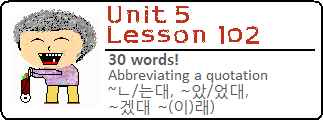 Lesson 102: In this lesson, you will learn more ways to abbreviate Korean sentences. In the previous lesson, you learned about common ways that Korean people shorten their sentences in messaging or when talking on the internet. In this lesson, you will learn how to abbreviate conjugations of quoted sentences. Lesson 102: In this lesson, you will learn more ways to abbreviate Korean sentences. In the previous lesson, you learned about common ways that Korean people shorten their sentences in messaging or when talking on the internet. In this lesson, you will learn how to abbreviate conjugations of quoted sentences.
This Lesson is also available in Español |
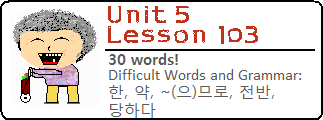 Lesson 103: In this lesson, you will learn a variety of smaller grammatical principles that are similar to grammatical principles you have learned previously. I will use this lesson to introduce you to: 한 and 약, ~(으)므로, 전반에, and 당하다. Lesson 103: In this lesson, you will learn a variety of smaller grammatical principles that are similar to grammatical principles you have learned previously. I will use this lesson to introduce you to: 한 and 약, ~(으)므로, 전반에, and 당하다.
This Lesson is also available in Español |
 Lesson 104: In this lesson, we will revisit the particle ~는/은. Yes, the same particle that you have been using in every one of your Korean sentences since you started learning Korean. In this lesson, you will learn how to apply ~는/은 to more complicated scenarios. Lesson 104: In this lesson, we will revisit the particle ~는/은. Yes, the same particle that you have been using in every one of your Korean sentences since you started learning Korean. In this lesson, you will learn how to apply ~는/은 to more complicated scenarios.
This Lesson is also available in Español |
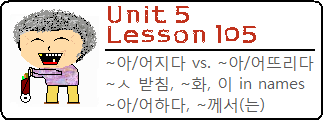 Lesson 105: The title of this lesson is: Grammatical principles that I can’t believe I haven’t taught you yet – and I better teach them to you now before we get too deep into more difficult grammatical principles in Unit 5. In this lesson, you will learn a variety of smaller grammatical principles that you absolutely need to know to be able to speak/read/understand Korean. Lesson 105: The title of this lesson is: Grammatical principles that I can’t believe I haven’t taught you yet – and I better teach them to you now before we get too deep into more difficult grammatical principles in Unit 5. In this lesson, you will learn a variety of smaller grammatical principles that you absolutely need to know to be able to speak/read/understand Korean.
This Lesson is also available in Español |
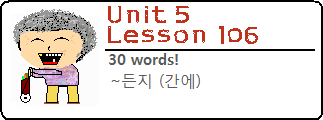 Lesson 106: In this lesson, you will learn how to add ~든지 to the end of a clause. Although this grammatical principle has a fairly straightforward meaning across the board, it can be used in a bunch of different ways. Lesson 106: In this lesson, you will learn how to add ~든지 to the end of a clause. Although this grammatical principle has a fairly straightforward meaning across the board, it can be used in a bunch of different ways.
This Lesson is also available in Español |
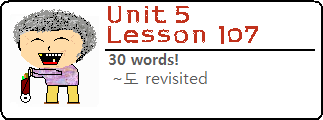 Lesson 107: The purpose of this lesson is to familiarize you with these grammatical principles when they are combined with ~도. Sometimes, the meaning that is created by combining ~도 with another grammatical principle is just the sum of their individual meanings. However, sometimes their meaning can be slightly – or very – different. Lesson 107: The purpose of this lesson is to familiarize you with these grammatical principles when they are combined with ~도. Sometimes, the meaning that is created by combining ~도 with another grammatical principle is just the sum of their individual meanings. However, sometimes their meaning can be slightly – or very – different.
This Lesson is also available in Español |
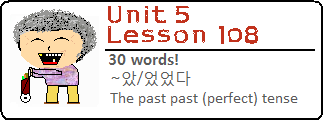 Lesson 108: In this lesson, you will learn the meaning of a grammatical principle that, by this point, you have probably noticed a few times in your Korean studies. Have you ever seen words in the past tense conjugated with an additional “었”? As in, 했었다 instead of 했다? In this lesson, we will look at the meaning of this additional “었” Lesson 108: In this lesson, you will learn the meaning of a grammatical principle that, by this point, you have probably noticed a few times in your Korean studies. Have you ever seen words in the past tense conjugated with an additional “었”? As in, 했었다 instead of 했다? In this lesson, we will look at the meaning of this additional “었”
This Lesson is also available in Español |
 Lessons 101 – 108 Mini Test: Test yourself on what you learned from Lessons 101 to 108! Lessons 101 – 108 Mini Test: Test yourself on what you learned from Lessons 101 to 108!
This Mini-Test is also available in Español |
| Click here to check out Unit 5: Lessons 109 – 116 |

